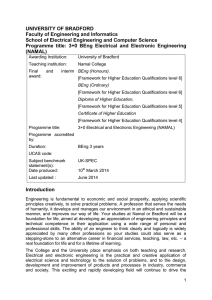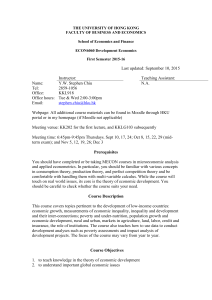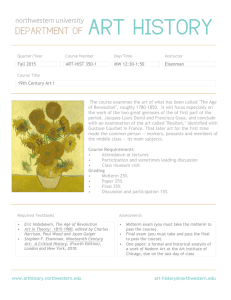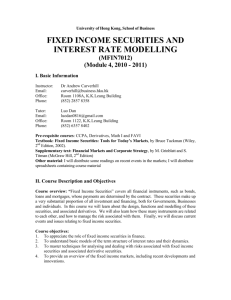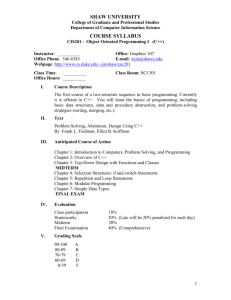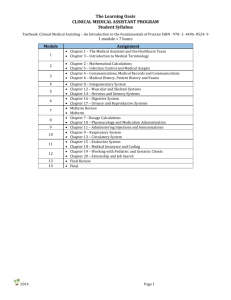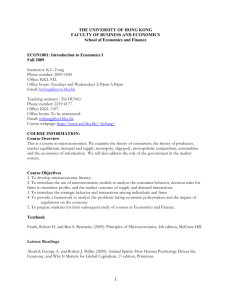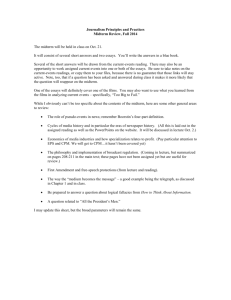Corporate Finance J - the School of Economics and Finance
advertisement
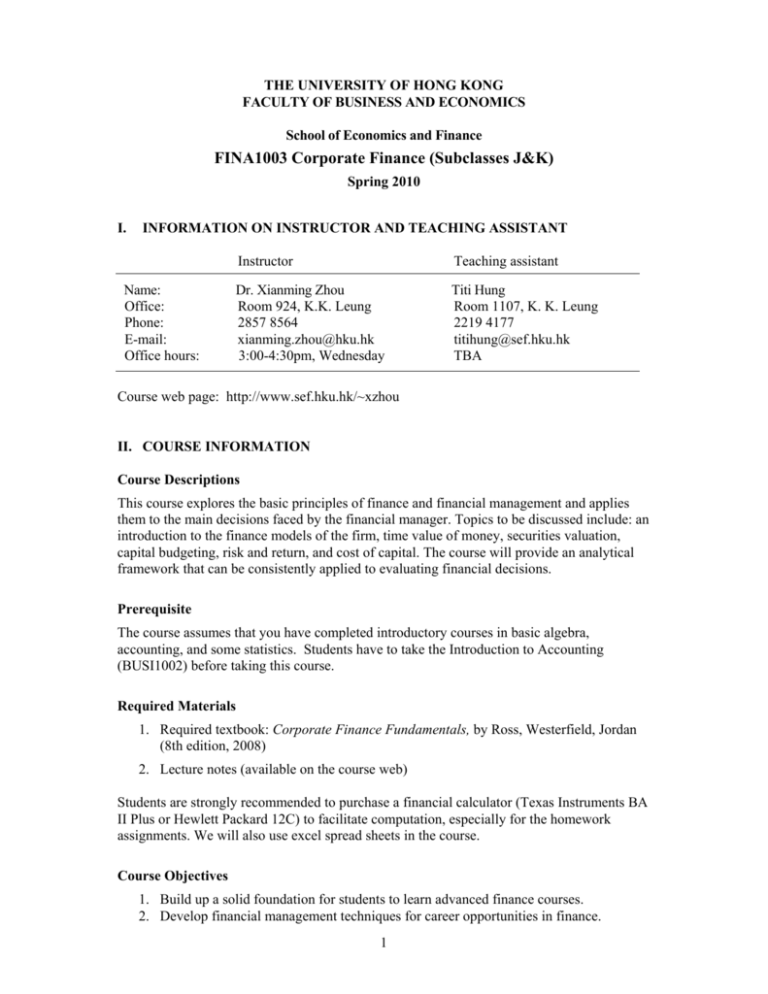
THE UNIVERSITY OF HONG KONG FACULTY OF BUSINESS AND ECONOMICS School of Economics and Finance FINA1003 Corporate Finance (Subclasses J&K) Spring 2010 I. INFORMATION ON INSTRUCTOR AND TEACHING ASSISTANT Name: Office: Phone: E-mail: Office hours: Instructor Teaching assistant Dr. Xianming Zhou Room 924, K.K. Leung 2857 8564 xianming.zhou@hku.hk 3:00-4:30pm, Wednesday Titi Hung Room 1107, K. K. Leung 2219 4177 titihung@sef.hku.hk TBA Course web page: http://www.sef.hku.hk/~xzhou II. COURSE INFORMATION Course Descriptions This course explores the basic principles of finance and financial management and applies them to the main decisions faced by the financial manager. Topics to be discussed include: an introduction to the finance models of the firm, time value of money, securities valuation, capital budgeting, risk and return, and cost of capital. The course will provide an analytical framework that can be consistently applied to evaluating financial decisions. Prerequisite The course assumes that you have completed introductory courses in basic algebra, accounting, and some statistics. Students have to take the Introduction to Accounting (BUSI1002) before taking this course. Required Materials 1. Required textbook: Corporate Finance Fundamentals, by Ross, Westerfield, Jordan (8th edition, 2008) 2. Lecture notes (available on the course web) Students are strongly recommended to purchase a financial calculator (Texas Instruments BA II Plus or Hewlett Packard 12C) to facilitate computation, especially for the homework assignments. We will also use excel spread sheets in the course. Course Objectives 1. Build up a solid foundation for students to learn advanced finance courses. 2. Develop financial management techniques for career opportunities in finance. 1 Corporate Finance (Spring 2010) University of Hong Kong Course Intended Learning Outcomes (ILOs) Upon the successful completion of this course, students should be able to ILO1. ILO2. ILO3. ILO4. ILO5. Understand the fundamental financial management concepts and process. Apply the time value of money concepts to security valuation and capital budgeting. Evaluate managerial decisions in corporate investing, financing and payout activities. Understand how capital structure decisions affect firm value. Develop skills in identifying and analyzing financial problems as well as team working skill. Alignments of Program and Course ILOs Program ILOs 1. Acquisition and internalization of knowledge of economics & finance Course ILOs ILO1, ILO2, ILO3, ILO4 2. Application and integration of knowledge ILO2, ILO3, ILO5 3. Developing global outlook ILO1, ILO3, ILO4 4. Mastering communication skills ILO3, ILO5 Teaching and Learning Activities (TLAs) TLA1 TLA2 TLA3 TLA4 TLA5 Lectures: Instructor will give lectures on major concepts and issues. Homework: In addition to regular assignment questions, students are encouraged to work on problems at the end of each chapter of the textbook. Students are required to submit a term project report. The objective of the project is to give students an opportunity to study in depth about corporate finance, which demonstrates students’ ability of using and integrating the tools and concepts covered in the course. Tutorials: The teaching assistant will use weekly tutorials to discuss answers to the assignments and illustrate important examples. Consultation: Both instructor and teaching assistant will hold weekly office hours, although students can also discuss questions with the instructor and TA by email. Class participation: Given usually large class size of this course, student class participation is hard to reinforce. However, students are encouraged to raise questions in class and actively participate in class discussion. 2 Corporate Finance (Spring 2010) University of Hong Kong Assessment Students’ final grade in this course will depend on four performance components, which are: A1. Assignments A2. Midterm test Final exam A3. Term project Total 10% 30% 45% 15% 100% Assignments Students will complete individually four assignments in this course. Assignments must be typed and handed in on time. Late assignments are not allowed. Exams The midterm test and final exam will be closed-book. There will be no supplementary test for the midterm. In case a student cannot take the midterm due to medical or other emergency reasons (for which supporting document is needed), the assessment weight for the midterm will be added to the final. Term project Students should form project groups (each consisting of two to four students) to do their term project. Students are free to choose the topic of their project as long as it is related to corporate finance, and are encouraged to discuss the topic with the instructor as early as possible. Students are required to prepare a report that should contain the executive summary (one page), main text (five to eight pages), supporting exhibits (tables and figures), and cited references. Relationship among ILOs, TLAs and Assessment ILO Teaching and Learning Activities (TLAs) 1 2 3 4 5 1 ✓ ✓ ✓ ✓ 2 ✓ ✓ ✓ ✓ 3 ✓ ✓ ✓ ✓ 4 ✓ ✓ ✓ ✓ ✓ 5 ✓ Assessment (A) 1 2 3 ✓ ✓ ✓ ✓ ✓ ✓ ✓ ✓ ✓ ✓ ✓ ✓ ✓ ✓ ✓ 3 ✓ Corporate Finance (Spring 2010) University of Hong Kong Standards of Assessment Exams and assignments are graded based on the following criteria: Grade A+, A, A- Criteria Provide correct solutions to no less than 90% of all problems, and give detailed and insightful responses to essay questions. B+, B, B- Provide correct solutions to 75-90% of all problems, and give detailed responses to some essay questions. C+, C, C- Provide correct solutions to 60-75% of all problems, and give limited responses to some essay questions. D+, D F Provide correct solutions to 50-60% of problems, and give unclear responses to most essay questions. Provided correct solutions to less than 50% of all problems, and give poor responses to most essay questions. The term project is graded using the following criteria: identification of the problem (25%), explanation of analysis (50%), and presentation and writing (including grammar, punctuation, spelling, etc) (25%). Grade A+, A, A- Criteria Very good to excellent ratings on some or all three criteria. B+, B, B- Good to very good ratings on some or all three criteria. C+, C, C- Fair to good ratings on some or all three criteria. D+, D Fair ratings on all three criteria. F Fail to submit the case synthesis. III. ACADEMIC AND CLASS CONDUCT The University Regulations on academic dishonesty will be strictly enforced. Please check the University Statement on plagiarism on the web: http://www.hku.hk/plagiarism/ Academic dishonesty is behavior in which a deliberately fraudulent misrepresentation is employed in an attempt to gain undeserved intellectual credit, either for oneself or for another. It includes, but is not necessarily limited to, the following types of cases: Plagiarism – The representation of someone else’s ideas as if they are one’s own. Where the arguments, data, designs, etc., of someone else are being used in a paper, report, oral presentation, or similar academic project, this fact must be made explicitly clear by citing the appropriate references. The references must fully indicate the extent to which any parts of the project are not one’s own work. Paraphrasing of someone else’s ideas is still using someone else’s ideas, and must be acknowledged. 4 Corporate Finance (Spring 2010) University of Hong Kong Unauthorized collaboration on out-of-class projects – The representation of work as solely one’s own when in fact it is the result of a joint effort. Cheating on exams – The covert gathering of information from other students, the use of unauthorized notes, unauthorized aids, etc. Unauthorized advance access to an exam –The representation of materials prepared at leisure, as a result of unauthorized advance access (however obtained), as if it were prepared under the rigors of the exam setting. This misrepresentation is dishonest in itself even if there are not compounding factors, such as unauthorized uses of books or notes. Where a candidate for a degree or other award uses the work of another person or persons without due acknowledgement: 1. The relevant Board of Examiners may impose a penalty in relation to the seriousness of the offence; 2. The relevant Board of Examiners may report the candidate to the Senate, where there is prima facie evidence of an intention to deceive and where sanctions beyond those in (1) might be invoked. If you are caught in an act of academic dishonesty or misconduct, you will receive an ‘F’ grade for the subject. If your term project submitted has been discovered to be an exact copy of someone else’s work, all students involved will be subject to the penalty for the act of plagiarizing or copying. IV. COURSE SCHEDULE (tentative) Teaching week 1 2 3 4 5 6 7 8 9 10 11 12 13 Topic Introduction, financial statement, cash flows Time value of money Discounted cash flow valuation Bond valuation Stock valuation NPV and other investment criteria Making investment decisions Midterm: 10:30-12:00, Saturday, March 13 (to be confirmed) Project analysis and evaluation Capital market history, risk and return Cost of capital Raising capital Capital structure policy Dividends and dividend policy 5 Chapters 1, 2 5 6 7 8 9 10 11 12, 13 15 16 17 18
